Benjamin Lay, the “fearless” subject of a new biography, is no longer a household name. But in the first half of nineteenth century, portraits of the white-bearded, hunchbacked “dwarf ” (as he is described in the new biography) graced many an American Quaker home. Wilford P. Cole writes about the century-long history of these often artless images, noting that Lay’s image was “repeatedly invoked in behalf of the growing reform spirit in American life.” Why was Lay such a famous character?
In Lay’s own day (1682-1759), some Quakers grew rich on slavery. This was contrary to the beliefs of George Fox, the sect’s founder, who felt equality and slavery couldn’t coexist. The radical Lay, dubbed the “Quaker Comet,” set out to end this state of affairs as a militant dissenter and gadfly.
As Andreas Mielke notes, biographical material about Benjamin Lay has been hard to come by. Mielke’s research into monthly Meeting records brought new facts to light about Lay’s life and his marriage to Sarah Smith, evidently also a hunchback, in England in 1718.
Trained as a glove-maker, Lay tried life at sea, where he learned about slavery in the Near East. After marrying Sarah, the couple moved to Barbados to open a shop. The grim slave-economy on that island was an upsetting revelation for them, compelling them back to England by 1720. In England, Benjamin was in constant trouble with his fellow Quakers, although Sarah, a minister in her own right, seems to have maintained her good standing.
In 1732, the Lays came to America, to settle near Philadelphia. This is where Lay came into his own as a prophet, albeit unrecognized by many of his own coreligionists. In fact, he was bodily thrown out of Meetings more often that not. A vegetarian, and vocal in opposition to the death penalty, he made his own clothes and boycotted slave products like sugar, rum, and cotton goods. Some have called him the first sit-down striker. Technically, he was a lay-down striker. After a bouncer unceremoniously threw him out of a Meeting, he refused to get off the ground, forcing the congregation to step over him on their way out. Although small, Lay harangued slave owners, smashed crockery, splattered “blood” (actually pokeberry juice) over congregants, and briefly abducted a slave-owner’s child.
Lay’s major work, All Slave-Keepers That Keep the Innocent in Bondage, Apostates, was printed by Benjamin Franklin in 1737. Franklin, who was friendly with Lay and later owned a portrait of him, was then still a slave owner. Lay’s arguments against slavery in one of the earliest abolitionist works published in America contributed to Franklin’s own eventual turn against slavery. But back in 1737, Franklin kept his and his print shop’s name off Lay’s incendiary book.
Weekly Digest
Sarah Lay seems to have been able to smooth things over with the Quakers, despite all her husband’s theatrics. After her death in 1736, however, he was disowned by his local faction. But he kept on agitating. It seemed you could not keep the Comet quiet or still.
By 1761, just a few years after his death, Quakers on both sides of the Atlantic were barred from owning slaves. And they remembered the eccentric firebrand who helped set them on that path.







